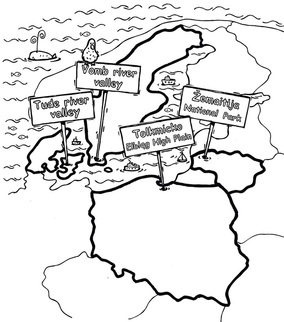New! LIFEscape report on Landscape Values is now available for download
Methods for measuring perceived landscape values and participation

Following methodology was developed by the Linnaues University team of Marianne Henningsson, Sofia Jönsson and Monika Borgö, and applied by all LIFEscape partners.
Focus groups interviews were performed during 2011 and spring 2012 in the four participating countries: Poland, Lithuania, Denmark and Sweden. A focus group interview includes about 6 to 8 persons from approximately the same area (occupation, interest field). It could be a group of land owners, a group of politicians, civil servants, an NGO, a group of tourists or citizens etc. The aim was to discuss a specific topic and to collect as many perspectives as possible on that topic. In our case we used the topic ‘landscape’ in general and landscape perceptions (ecological, cultural social values) in the specific areas, chosen for the project.
The objective by performing focus groups interviews is to get a dynamic discussion within the group, that is, the participants discuss and exchange their experiences. The researchers make notes, but they also lead the discussion. An interview manual was used by the researchers at the interviews, and the same questions were put in all four participating countries. Each interview lasted for about one hour. The interview manual included questions on the participants´ perceptions of the word ‘landscape’, on the participants´ opinions on important landscapes in the world, in their country and which values were important in the chosen areas: Tolkmicko (PL), Żemaitija (LT), Vombsänkan (SE) and Tude Å (DK). Other questions concerned perceptions on participation in the planning process and in the development of the area. The interviews were recorded and transcribed. The transcribed material was then categorized into six categories (see below). The categorized material was translated into English and spread to the method group.
Focus groups interviews were performed during 2011 and spring 2012 in the four participating countries: Poland, Lithuania, Denmark and Sweden. A focus group interview includes about 6 to 8 persons from approximately the same area (occupation, interest field). It could be a group of land owners, a group of politicians, civil servants, an NGO, a group of tourists or citizens etc. The aim was to discuss a specific topic and to collect as many perspectives as possible on that topic. In our case we used the topic ‘landscape’ in general and landscape perceptions (ecological, cultural social values) in the specific areas, chosen for the project.
The objective by performing focus groups interviews is to get a dynamic discussion within the group, that is, the participants discuss and exchange their experiences. The researchers make notes, but they also lead the discussion. An interview manual was used by the researchers at the interviews, and the same questions were put in all four participating countries. Each interview lasted for about one hour. The interview manual included questions on the participants´ perceptions of the word ‘landscape’, on the participants´ opinions on important landscapes in the world, in their country and which values were important in the chosen areas: Tolkmicko (PL), Żemaitija (LT), Vombsänkan (SE) and Tude Å (DK). Other questions concerned perceptions on participation in the planning process and in the development of the area. The interviews were recorded and transcribed. The transcribed material was then categorized into six categories (see below). The categorized material was translated into English and spread to the method group.
|
Categories:
|
The interest groups interviewed (in the four countries) were:
|
The result of the categorization from all participating countries was put together and analyzed. The material was used as a basic material for developing a questionnaire, suitable for the participating countries. A suggestion on a questionnaire was made by the Linnaeus University and the suggestion was commented upon by all countries. Changes were made and the questionnaire was translated into four languages.
To be able to use the questionnaire on line as much as possible, we developed a web survey together with experts at the Linnaeus University. The technical process was complicated but the four questionnaire versions were ready to be tested in the beginning of 2013. Paper versions of the questionnaire were also available. In some cases, the distribution was performed face to face (e.g. school children, tourists…) or to other groups which not could be reached by e-mail. On total, around 900 questionnaires have been collected in all countries to groups presented above. Results of their analysis are presented in the summary report.
To be able to use the questionnaire on line as much as possible, we developed a web survey together with experts at the Linnaeus University. The technical process was complicated but the four questionnaire versions were ready to be tested in the beginning of 2013. Paper versions of the questionnaire were also available. In some cases, the distribution was performed face to face (e.g. school children, tourists…) or to other groups which not could be reached by e-mail. On total, around 900 questionnaires have been collected in all countries to groups presented above. Results of their analysis are presented in the summary report.
